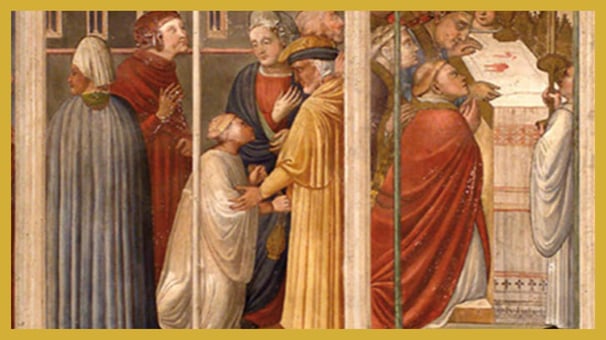History of the Jubilee
Index
Origins of the Jubilee
The Evolution of the Tradition
The Meaning of the Indulgence
The Jubilee and Rome
Conclusion
The Jubilee is one of the Catholic Church's most ancient and profound traditions, a spiritual event that has spanned centuries, carrying with it deep theological and historical significance. Its origins and evolution are deeply rooted in Rome, intertwined with Saint Peter’s Basilica, the Holy Door, and the concept of indulgence.


Origins of the Jubilee
The concept of the Jubilee has its roots in the Old Testament, where every fifty years a Holy Year was declared, dedicated to letting the land rest, freeing slaves, and returning properties to their rightful owners (Leviticus 25:8-13). This extraordinary time of grace and mercy was adopted by the Catholic Church and transformed into an event of universal scope.
The first Catholic Jubilee was proclaimed by Pope Boniface VIII in 1300. Initially celebrated every hundred years, this event drew an extraordinary number of pilgrims to Rome. The faithful were invited to visit Saint Peter's Basilica and Saint Paul Outside the Walls to receive a plenary indulgence, granting remission of temporal punishment for sins already confessed.
Learn more about the origins and evolution of the Jubilee in our dedicated section within the Jubilee sin History.
The Evolution of the Tradition
Following the inaugural Jubilee of 1300, its frequency was adjusted over time. In 1343, Pope Clement VI reduced the interval to fifty years. Later, Pope Urban VI further shortened it to 33 years, reflecting the life of Christ. Finally, in 1470, Pope Paul II established the current rhythm of a Jubilee every 25 years—a tradition that endures to this day.
One of the most significant additions to the Jubilee was the Holy Door, introduced by Pope Alexander VI in 1500. This special portal, opened only during the Holy Year, can be found in Rome’s four major basilicas: Saint Peter's, Saint John Lateran, Saint Mary Major, and Saint Paul Outside the Walls. Crossing the Holy Door is a profound act of devotion, symbolizing the passage from sin to grace.
Discover the meaning of the Holy Door, its ceremonies, and explore the key basilicas of Rome involved in the Jubilee.
The Meaning of Indulgence
Central to the Jubilee is the granting of plenary indulgence, an act of mercy through which the Church, empowered by Christ's authority given to Peter, offers the remission of temporal punishment for sins already confessed. To obtain this indulgence during the Holy Year, the faithful must fulfill certain conditions: sacramental confession, Eucharistic communion, prayer for the Pope’s intentions, and crossing the Holy Door.
The indulgence serves as a unique opportunity for believers to renew their spiritual lives and experience God’s forgiveness and mercy. During the Jubilee, indulgence becomes the heart of the celebration—a moment of reconciliation and spiritual purification embraced by millions.
For more details on how to obtain the Jubilee indulgence, visit our comprehensive guide.
The Jubilee and Rome
Rome, with its iconic basilicas, stands at the heart of the Jubilee. Each Holy Year, the Eternal City transforms into a grand center of pilgrimage, welcoming millions of faithful from around the globe. Saint Peter’s Basilica, with its magnificent dome designed by Michelangelo, serves as the spiritual epicenter of the event. It is here that the main liturgical celebrations, led by the Pope, take place, beginning and concluding the Jubilee with the ceremonial opening and closing of the Holy Door.
Explore the history and impact of the Jubilees on the city of Rome and discover how the Eternal City prepares to welcome pilgrims.
Conclusion
The history of the Jubilee Year is a testament to the Catholic Church’s ability to renew and adapt, preserving a millennial tradition that continues to inspire millions. The Jubilee is not merely a religious event; it is a time for deep reflection, repentance, and spiritual rebirth. Through the Holy Door, Rome’s basilicas, and the gift of indulgence, the faithful are invited to embark on a journey of faith that draws them closer to God and strengthens their spiritual community.
If you’re interested in participating in Jubilee 2025, don’t miss our section on planning a pilgrimage to Rome and preparing spiritually to fully embrace this extraordinary experience of faith.
Drop us a line
Follow us
Discover the Jubilee
Experience the Jubilee
Jubilee locations
Get ready for the Jubilee
Rome and the Jubilee
